
Agrochola lychnidis, the beaded chestnut, is a moth of the family Noctuidae. The species was first described by Michael Denis and Ignaz Schiffermüller in 1775. It is distributed throughout the whole of Europe from Ireland to the Urals. It also occurs in western North Africa and Asia Minor.
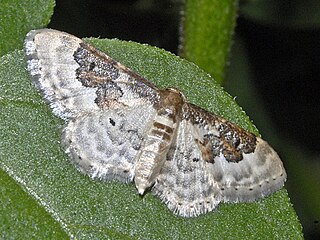
Idaea rusticata, the least carpet, is a moth of the family Geometridae. The species was first described by Michael Denis and Ignaz Schiffermüller in 1775.
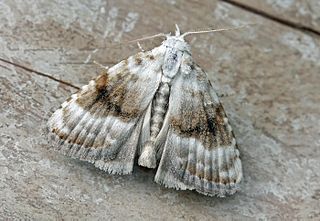
Meganola albula, the Kent black arches, is a moth of the family Nolidae. The species was first described by Michael Denis and Ignaz Schiffermüller in 1775. It is found in the Palearctic realm.
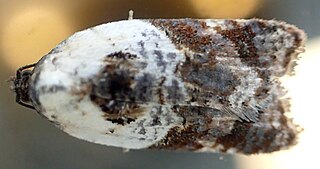
Acleris variegana, the garden rose tortricid moth or fruit tortricid, is a moth of the family Tortricidae. It has a Palearctic distribution. The moth flies from July to September mainly at night and is attracted to bright lights. The larvae feed on various trees and shrubs including rose and apple.

Argyresthia pygmaeella is a moth of the family Yponomeutidae. The species was first described by Michael Denis and Ignaz Schiffermüller in 1775 from a specimen found near Vienna, Austria

Gillmeria ochrodactyla is a moth of the family Pterophoridae found in Asia and Europe. It was first described by the Austrian entomologists, Michael Denis & Ignaz Schiffermüller in 1775.

Cnaemidophorus rhododactyla, also known as the rose plume moth, is a moth of the superfamily Pterophoroidea, family Pterophoridae. It is found in the Northern Hemisphere, except for Greenland, Southeast Asia, and most of North Africa. It was first described by Michael Denis and Ignaz Schiffermüller, 1775.

Platyptilia gonodactyla, also known as the triangle plume, is a moth of the family Pterophoridae found in temperate Asia and Europe. It was first described by the Austrian entomologists, Michael Denis & Ignaz Schiffermüller in 1775.

Minucia lunaris, the lunar double-stripe or brown underwing, is a species of moth in the family Erebidae. The species was first described by Michael Denis and Ignaz Schiffermüller in 1775 and is found in Asia, Europe and North Africa.
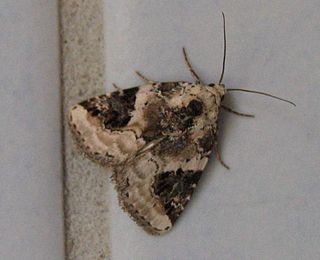
Pseudeustrotia candidula, the shining marbled, is a moth of the family Noctuidae. The species was first described by Michael Denis and Ignaz Schiffermüller in 1775. It can be found from Europe to Japan.

Catephia alchymista, the white underwing or alchymist, is a moth in the family Erebidae found in Asia, Europe and North Africa. The species was first described by Michael Denis and Ignaz Schiffermüller in 1775.

Mompha epilobiella is a moth in the family Momphidae found in Europe and North America.

Meganola strigula, the small black arches, is a moth of the family Nolidae. The species was first described by Michael Denis and Ignaz Schiffermüller in 1775. It is found in Europe, Russia and Asia Minor.

Mompha ochraceella is a moth of the family Momphidae found in Africa, Asia and Europe.

Platyptilia calodactyla is a moth of the family Pterophoridae found in Asia and Europe. It was first described by the Austrian entomologists, Michael Denis & Ignaz Schiffermüller in 1775.

Merrifieldia leucodactyla, also known as the thyme plume, is a moth of the family Pterophoridae, and is known from most of Europe, as well as North Africa and Asia Minor. It was first described by the Austrian lepidopterists, Michael Denis and Ignaz Schiffermüller in 1775).

Pareulype berberata, the barberry carpet moth, is a moth of the family Geometridae. The species was first described by Austrian lepidopterists, Michael Denis and Ignaz Schiffermüller in 1775. The moth is found in Africa, Asia and Europe.

Mompha is a genus of moths in the family Momphidae that was first described by Jacob Hübner in 1819. It has four subgenera.
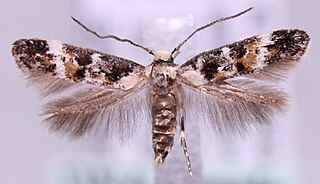
Mompha lacteella is a moth in the family Momphidae found in Asia and Europe.
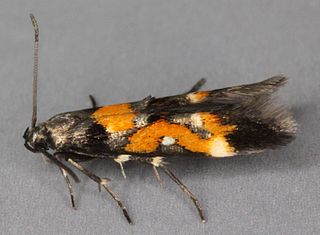
Mompha locupletella is a moth in the family Momphidae that can be found in the Palearctic including Europe.




















